Attractions · Events · Going Out · Mexico · North America · Regions · Travel Miscellany
Celebrating Day of the Dead in Mérida
The biggest celebration in Mexico, the Day of the Dead (Hanal Pixan), takes place between 28th October and 2nd November and is becoming so popular, even London had its very own festival in 2017, sponsored by the popular restaurant chain Wahaca. The festival paid special tribute to victims of the tragic Earthquake in Mexico City just two months prior in September 2017. The latest Disney-Pixar movie Coco, due for release in the UK on 19th January 2018, is set to pin this festival firmly on our hearts and in our minds!
 To experience this tradition at full volume, it’s best to visit Mexico. Mérida, capital of the Yucatán state, is hailed not only as the ‘White City’ but also as the safest city in Mexico due to its low crime rates, and has its own unique take on this vibrant celebration.
To experience this tradition at full volume, it’s best to visit Mexico. Mérida, capital of the Yucatán state, is hailed not only as the ‘White City’ but also as the safest city in Mexico due to its low crime rates, and has its own unique take on this vibrant celebration.
 The first thing that strikes me about Mérida is the warm welcome extended by the friendly locals. There is a distinctly older demographic here, with weekly open-air dance events being attended by locals well into their 70s and 80s. The colonial buildings of this old town maintain a certain dishevelled charm matched only by little old ladies driving rusty VW Beetles. Mérida got its name when the conquistadors took over the Mayan settlement of T’ho in 1542. T’ho was renamed Mérida, after a town it resembles in Spain, and its indigenous Mayan beliefs were slowly infused with those of the newly arrived Catholicism.
The first thing that strikes me about Mérida is the warm welcome extended by the friendly locals. There is a distinctly older demographic here, with weekly open-air dance events being attended by locals well into their 70s and 80s. The colonial buildings of this old town maintain a certain dishevelled charm matched only by little old ladies driving rusty VW Beetles. Mérida got its name when the conquistadors took over the Mayan settlement of T’ho in 1542. T’ho was renamed Mérida, after a town it resembles in Spain, and its indigenous Mayan beliefs were slowly infused with those of the newly arrived Catholicism.
 What is Day of the Dead all about?
Firstly, it’s a family affair, all about celebrating loved ones who no longer share this life with us. It is believed that during these couple of days, their souls can pass more easily between this world and the afterlife. To facilitate this, altars are set up, for the children (Dia de los Innocentes) on 31st October, and then the following day for adults. Altars are decorated with items such as orange marigold flowers, painted or sugar skulls, food, such as Mucbipollo and Pan de Muerto (the sweet bread of the dead) and crucifixes. The altar is then personalised with a picture of the deceased. These altars are most commonly created in the privacy of the family home, but can also be found in cemeteries, on the street, in restaurants and also in your hotel foyer.
What is Day of the Dead all about?
Firstly, it’s a family affair, all about celebrating loved ones who no longer share this life with us. It is believed that during these couple of days, their souls can pass more easily between this world and the afterlife. To facilitate this, altars are set up, for the children (Dia de los Innocentes) on 31st October, and then the following day for adults. Altars are decorated with items such as orange marigold flowers, painted or sugar skulls, food, such as Mucbipollo and Pan de Muerto (the sweet bread of the dead) and crucifixes. The altar is then personalised with a picture of the deceased. These altars are most commonly created in the privacy of the family home, but can also be found in cemeteries, on the street, in restaurants and also in your hotel foyer.
 Public festivities in Mérida begin on the night of 28th October, where a procession of locals carrying ceremonial offerings makes its way to the General Cemetery ‘El Paseo de las Almas’. People paint their faces and dress up as ‘Catrinas’, the satirical skeleton woman, lavishly dressed in aristocratic clothing, first created by a Mexican cartoonist (J,G, Posada) in the 1900s. The following evening, a stage is set up in the main square in front of the cathedral, and a theatrical show keeps the crowds in both fits of laughter and in tears with a tragic comedy.
Public festivities in Mérida begin on the night of 28th October, where a procession of locals carrying ceremonial offerings makes its way to the General Cemetery ‘El Paseo de las Almas’. People paint their faces and dress up as ‘Catrinas’, the satirical skeleton woman, lavishly dressed in aristocratic clothing, first created by a Mexican cartoonist (J,G, Posada) in the 1900s. The following evening, a stage is set up in the main square in front of the cathedral, and a theatrical show keeps the crowds in both fits of laughter and in tears with a tragic comedy.
 Most of the story is lost on me as its in Spanish, but the dance to Michael Jackson’s Thriller is very entertaining. Aside from this main performance, there are live bands and couples dancing in the street.
Most of the story is lost on me as its in Spanish, but the dance to Michael Jackson’s Thriller is very entertaining. Aside from this main performance, there are live bands and couples dancing in the street.
 The Vaquería Yucateca
This traditional dance performance takes place in the main square (Plaza Mayor) at around 9pm on Sundays and is a mixture of old Mayan songs and Spanish folklore, characterised by the combined sound of wind instruments such as clarinet and saxophone. During the week of celebrations, the dancers will also have their faces painted with skulls. Before the dancing can begin, a Shaman will bless the space with prayers and aromatic incense. Couples dressed in distinctive white ensembles appear through the smoke carrying candles.
The Vaquería Yucateca
This traditional dance performance takes place in the main square (Plaza Mayor) at around 9pm on Sundays and is a mixture of old Mayan songs and Spanish folklore, characterised by the combined sound of wind instruments such as clarinet and saxophone. During the week of celebrations, the dancers will also have their faces painted with skulls. Before the dancing can begin, a Shaman will bless the space with prayers and aromatic incense. Couples dressed in distinctive white ensembles appear through the smoke carrying candles.
 The women wear tunics embroidered with colourful flowers, beaded rosaries, shawls and flowers in their hair. The men wear panama hats, heeled wooden sandals, aprons and red neck-scarves, one leg of their trousers rolled up to bear the calf. They perform a unique tap dance style footwork to the ‘Jarana’ dances (which is also the name of a type of guitar), some of which include dancing round a Maypole and balancing a tray of drinks atop the flowered heads of the women. After the hour long performance, the dancers assemble around the altar and it’s possible to grab a photo with the stars of the show.
The women wear tunics embroidered with colourful flowers, beaded rosaries, shawls and flowers in their hair. The men wear panama hats, heeled wooden sandals, aprons and red neck-scarves, one leg of their trousers rolled up to bear the calf. They perform a unique tap dance style footwork to the ‘Jarana’ dances (which is also the name of a type of guitar), some of which include dancing round a Maypole and balancing a tray of drinks atop the flowered heads of the women. After the hour long performance, the dancers assemble around the altar and it’s possible to grab a photo with the stars of the show.
 Camino de Flores (flower walk)
This small but stunning garden can be found in the Parque de la Mejorada, and showcases endemic plants beautifully styled by local artists. Among the exhibits were 3 sculpted green guitarists, a white statue of a woman mourning at a verdant grave and a 2 metre high, two-faced man and woman with skull faces. This exhibition really weaves life and death together with the glorious plants, full of life, arranged to depict symbols of death. Ambient music is provided in the form of deep rumbling Mayan drums and flutes.
Camino de Flores (flower walk)
This small but stunning garden can be found in the Parque de la Mejorada, and showcases endemic plants beautifully styled by local artists. Among the exhibits were 3 sculpted green guitarists, a white statue of a woman mourning at a verdant grave and a 2 metre high, two-faced man and woman with skull faces. This exhibition really weaves life and death together with the glorious plants, full of life, arranged to depict symbols of death. Ambient music is provided in the form of deep rumbling Mayan drums and flutes.
 Mucbipollo Festival
This loud and busy event takes place around San Sebastian. The dish Mucbipollo (or pib) is a type of tamale made from chicken (pollo in Spanish) and cornflour, buried under the ground and baked (mucbi in Mayan). It is only eaten during the Day of the Dead festival, and some locals confessed to having eaten it for breakfast, lunch and dinner. Every stall sells their own variation of this dish, with slightly differing ingredients and consistencies. Find the stall mobbed by the biggest crowd or that has nearly sold out and you’re on to a winner.
Mucbipollo Festival
This loud and busy event takes place around San Sebastian. The dish Mucbipollo (or pib) is a type of tamale made from chicken (pollo in Spanish) and cornflour, buried under the ground and baked (mucbi in Mayan). It is only eaten during the Day of the Dead festival, and some locals confessed to having eaten it for breakfast, lunch and dinner. Every stall sells their own variation of this dish, with slightly differing ingredients and consistencies. Find the stall mobbed by the biggest crowd or that has nearly sold out and you’re on to a winner.
 As you peruse the stalls, a band plays live music on the stage to those who can manage to find a seat. The perfect drink for washing this down is provided in the form of Chaya, a healthy green leaf similar to spinach or kale which is blended into a juice. For those with a sweet tooth, there’s Horchata, a cold, white, milky drink made from pressed tiger nuts. Meanwhile, in a field next-door, the next batch of mucbipollo is being cooked up.
As you peruse the stalls, a band plays live music on the stage to those who can manage to find a seat. The perfect drink for washing this down is provided in the form of Chaya, a healthy green leaf similar to spinach or kale which is blended into a juice. For those with a sweet tooth, there’s Horchata, a cold, white, milky drink made from pressed tiger nuts. Meanwhile, in a field next-door, the next batch of mucbipollo is being cooked up.
 Around Mérida
As the Day of the Dead celebrations take place in the evening, daytimes are free to explore the surrounding areas, which include ancient Mayan ruins, cenotes, the National Park of Celestun and some great art galleries. One of the smallest but best galleries to visit in town is the Fundación de Artistas. On entering the tiny courtyard, we are greeted with the sounds of omming, which I instantly mistake for a Buddhist meditation class. It turns out to be part of the installation by artist Ruben Maya, which he composed especially for this show. Inside the dark gallery, his otherworldly sculptures have been painted in fluorescent sacred words from all over the world. Meanwhile, outside the sun shines on a trickling fountain, as world-class pianist, Seth Montfort, who has taken up a temporary residency here, gets ready to wow us with his classical repertoire. This is a truly wonderful place to sip a coffee and enjoy the delights of art and music!
Around Mérida
As the Day of the Dead celebrations take place in the evening, daytimes are free to explore the surrounding areas, which include ancient Mayan ruins, cenotes, the National Park of Celestun and some great art galleries. One of the smallest but best galleries to visit in town is the Fundación de Artistas. On entering the tiny courtyard, we are greeted with the sounds of omming, which I instantly mistake for a Buddhist meditation class. It turns out to be part of the installation by artist Ruben Maya, which he composed especially for this show. Inside the dark gallery, his otherworldly sculptures have been painted in fluorescent sacred words from all over the world. Meanwhile, outside the sun shines on a trickling fountain, as world-class pianist, Seth Montfort, who has taken up a temporary residency here, gets ready to wow us with his classical repertoire. This is a truly wonderful place to sip a coffee and enjoy the delights of art and music!

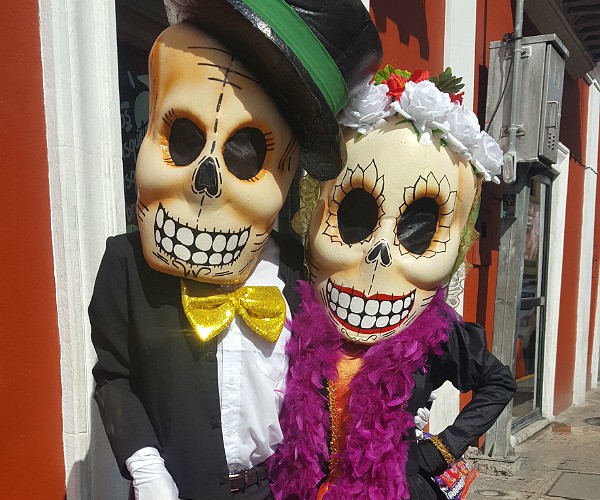 To experience this tradition at full volume, it’s best to visit Mexico. Mérida, capital of the Yucatán state, is hailed not only as the ‘White City’ but also as the safest city in Mexico due to its low crime rates, and has its own unique take on this vibrant celebration.
To experience this tradition at full volume, it’s best to visit Mexico. Mérida, capital of the Yucatán state, is hailed not only as the ‘White City’ but also as the safest city in Mexico due to its low crime rates, and has its own unique take on this vibrant celebration.
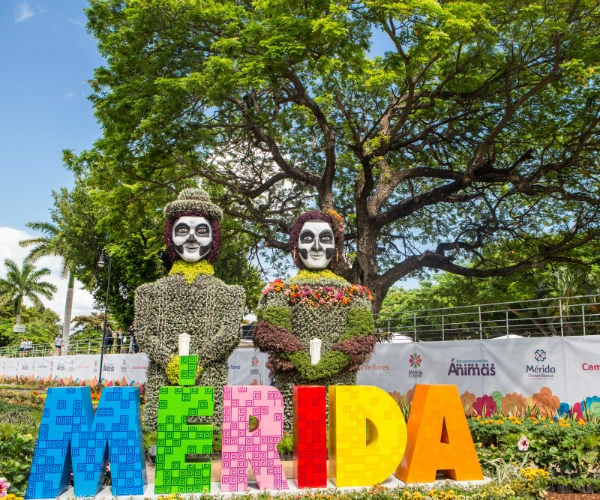 The first thing that strikes me about Mérida is the warm welcome extended by the friendly locals. There is a distinctly older demographic here, with weekly open-air dance events being attended by locals well into their 70s and 80s. The colonial buildings of this old town maintain a certain dishevelled charm matched only by little old ladies driving rusty VW Beetles. Mérida got its name when the conquistadors took over the Mayan settlement of T’ho in 1542. T’ho was renamed Mérida, after a town it resembles in Spain, and its indigenous Mayan beliefs were slowly infused with those of the newly arrived Catholicism.
The first thing that strikes me about Mérida is the warm welcome extended by the friendly locals. There is a distinctly older demographic here, with weekly open-air dance events being attended by locals well into their 70s and 80s. The colonial buildings of this old town maintain a certain dishevelled charm matched only by little old ladies driving rusty VW Beetles. Mérida got its name when the conquistadors took over the Mayan settlement of T’ho in 1542. T’ho was renamed Mérida, after a town it resembles in Spain, and its indigenous Mayan beliefs were slowly infused with those of the newly arrived Catholicism.
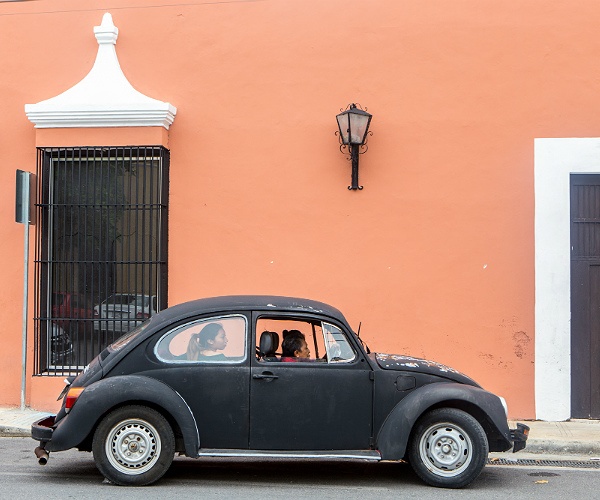 What is Day of the Dead all about?
Firstly, it’s a family affair, all about celebrating loved ones who no longer share this life with us. It is believed that during these couple of days, their souls can pass more easily between this world and the afterlife. To facilitate this, altars are set up, for the children (Dia de los Innocentes) on 31st October, and then the following day for adults. Altars are decorated with items such as orange marigold flowers, painted or sugar skulls, food, such as Mucbipollo and Pan de Muerto (the sweet bread of the dead) and crucifixes. The altar is then personalised with a picture of the deceased. These altars are most commonly created in the privacy of the family home, but can also be found in cemeteries, on the street, in restaurants and also in your hotel foyer.
What is Day of the Dead all about?
Firstly, it’s a family affair, all about celebrating loved ones who no longer share this life with us. It is believed that during these couple of days, their souls can pass more easily between this world and the afterlife. To facilitate this, altars are set up, for the children (Dia de los Innocentes) on 31st October, and then the following day for adults. Altars are decorated with items such as orange marigold flowers, painted or sugar skulls, food, such as Mucbipollo and Pan de Muerto (the sweet bread of the dead) and crucifixes. The altar is then personalised with a picture of the deceased. These altars are most commonly created in the privacy of the family home, but can also be found in cemeteries, on the street, in restaurants and also in your hotel foyer.
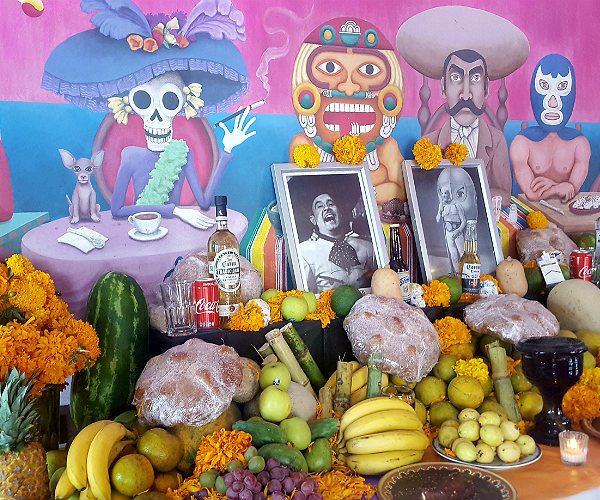 Public festivities in Mérida begin on the night of 28th October, where a procession of locals carrying ceremonial offerings makes its way to the General Cemetery ‘El Paseo de las Almas’. People paint their faces and dress up as ‘Catrinas’, the satirical skeleton woman, lavishly dressed in aristocratic clothing, first created by a Mexican cartoonist (J,G, Posada) in the 1900s. The following evening, a stage is set up in the main square in front of the cathedral, and a theatrical show keeps the crowds in both fits of laughter and in tears with a tragic comedy.
Public festivities in Mérida begin on the night of 28th October, where a procession of locals carrying ceremonial offerings makes its way to the General Cemetery ‘El Paseo de las Almas’. People paint their faces and dress up as ‘Catrinas’, the satirical skeleton woman, lavishly dressed in aristocratic clothing, first created by a Mexican cartoonist (J,G, Posada) in the 1900s. The following evening, a stage is set up in the main square in front of the cathedral, and a theatrical show keeps the crowds in both fits of laughter and in tears with a tragic comedy.
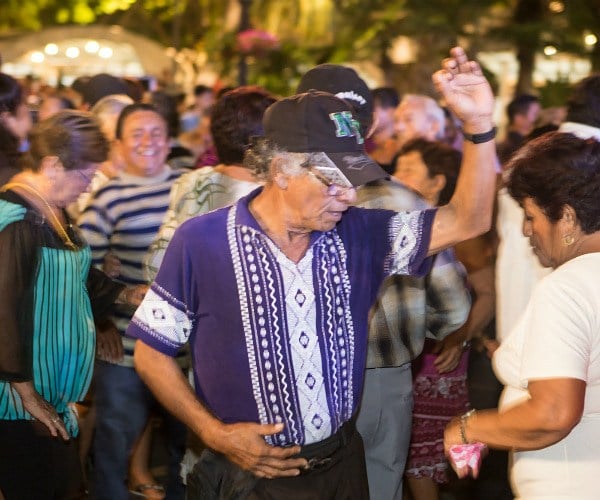 Most of the story is lost on me as its in Spanish, but the dance to Michael Jackson’s Thriller is very entertaining. Aside from this main performance, there are live bands and couples dancing in the street.
Most of the story is lost on me as its in Spanish, but the dance to Michael Jackson’s Thriller is very entertaining. Aside from this main performance, there are live bands and couples dancing in the street.
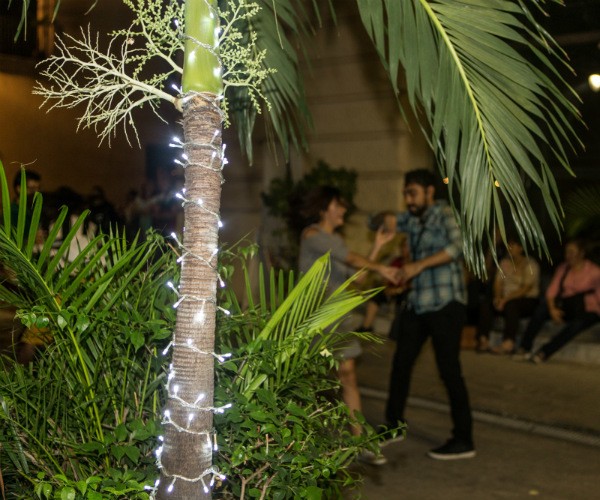 The Vaquería Yucateca
This traditional dance performance takes place in the main square (Plaza Mayor) at around 9pm on Sundays and is a mixture of old Mayan songs and Spanish folklore, characterised by the combined sound of wind instruments such as clarinet and saxophone. During the week of celebrations, the dancers will also have their faces painted with skulls. Before the dancing can begin, a Shaman will bless the space with prayers and aromatic incense. Couples dressed in distinctive white ensembles appear through the smoke carrying candles.
The Vaquería Yucateca
This traditional dance performance takes place in the main square (Plaza Mayor) at around 9pm on Sundays and is a mixture of old Mayan songs and Spanish folklore, characterised by the combined sound of wind instruments such as clarinet and saxophone. During the week of celebrations, the dancers will also have their faces painted with skulls. Before the dancing can begin, a Shaman will bless the space with prayers and aromatic incense. Couples dressed in distinctive white ensembles appear through the smoke carrying candles.
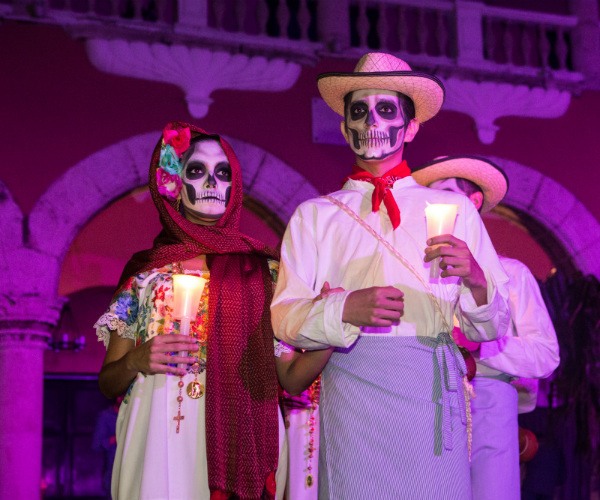 The women wear tunics embroidered with colourful flowers, beaded rosaries, shawls and flowers in their hair. The men wear panama hats, heeled wooden sandals, aprons and red neck-scarves, one leg of their trousers rolled up to bear the calf. They perform a unique tap dance style footwork to the ‘Jarana’ dances (which is also the name of a type of guitar), some of which include dancing round a Maypole and balancing a tray of drinks atop the flowered heads of the women. After the hour long performance, the dancers assemble around the altar and it’s possible to grab a photo with the stars of the show.
The women wear tunics embroidered with colourful flowers, beaded rosaries, shawls and flowers in their hair. The men wear panama hats, heeled wooden sandals, aprons and red neck-scarves, one leg of their trousers rolled up to bear the calf. They perform a unique tap dance style footwork to the ‘Jarana’ dances (which is also the name of a type of guitar), some of which include dancing round a Maypole and balancing a tray of drinks atop the flowered heads of the women. After the hour long performance, the dancers assemble around the altar and it’s possible to grab a photo with the stars of the show.
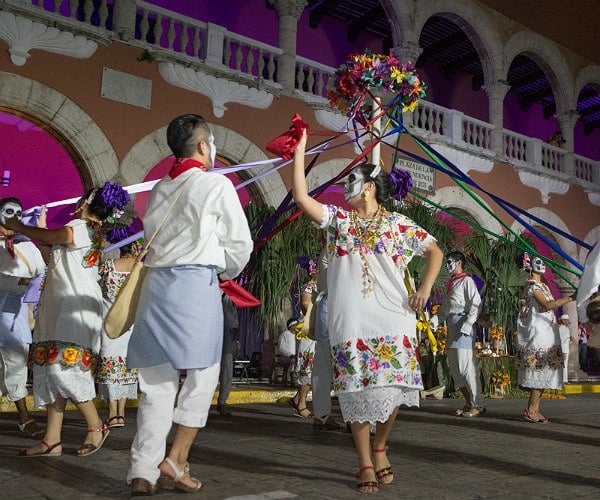 Camino de Flores (flower walk)
This small but stunning garden can be found in the Parque de la Mejorada, and showcases endemic plants beautifully styled by local artists. Among the exhibits were 3 sculpted green guitarists, a white statue of a woman mourning at a verdant grave and a 2 metre high, two-faced man and woman with skull faces. This exhibition really weaves life and death together with the glorious plants, full of life, arranged to depict symbols of death. Ambient music is provided in the form of deep rumbling Mayan drums and flutes.
Camino de Flores (flower walk)
This small but stunning garden can be found in the Parque de la Mejorada, and showcases endemic plants beautifully styled by local artists. Among the exhibits were 3 sculpted green guitarists, a white statue of a woman mourning at a verdant grave and a 2 metre high, two-faced man and woman with skull faces. This exhibition really weaves life and death together with the glorious plants, full of life, arranged to depict symbols of death. Ambient music is provided in the form of deep rumbling Mayan drums and flutes.
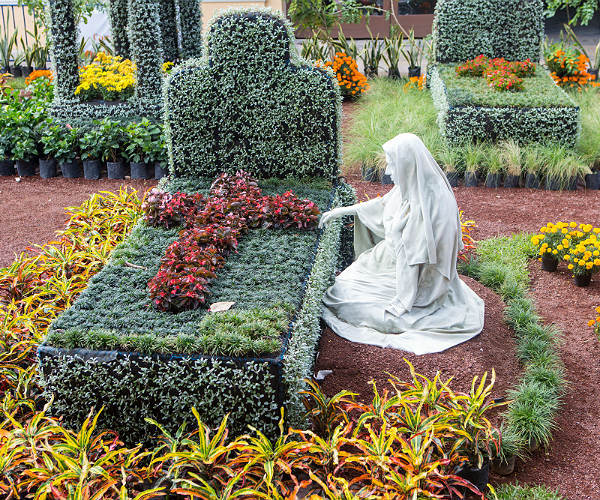 Mucbipollo Festival
This loud and busy event takes place around San Sebastian. The dish Mucbipollo (or pib) is a type of tamale made from chicken (pollo in Spanish) and cornflour, buried under the ground and baked (mucbi in Mayan). It is only eaten during the Day of the Dead festival, and some locals confessed to having eaten it for breakfast, lunch and dinner. Every stall sells their own variation of this dish, with slightly differing ingredients and consistencies. Find the stall mobbed by the biggest crowd or that has nearly sold out and you’re on to a winner.
Mucbipollo Festival
This loud and busy event takes place around San Sebastian. The dish Mucbipollo (or pib) is a type of tamale made from chicken (pollo in Spanish) and cornflour, buried under the ground and baked (mucbi in Mayan). It is only eaten during the Day of the Dead festival, and some locals confessed to having eaten it for breakfast, lunch and dinner. Every stall sells their own variation of this dish, with slightly differing ingredients and consistencies. Find the stall mobbed by the biggest crowd or that has nearly sold out and you’re on to a winner.
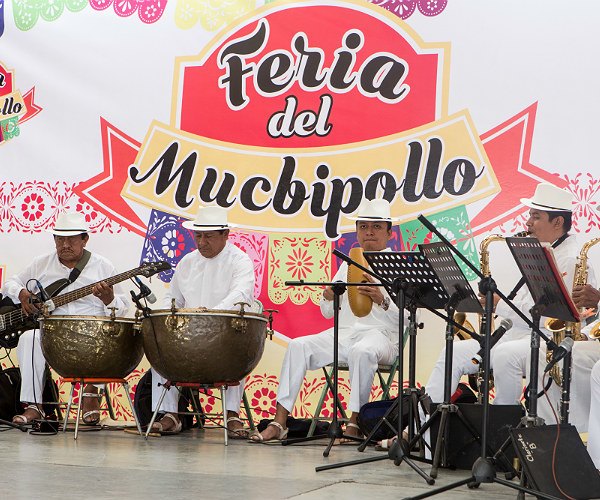 As you peruse the stalls, a band plays live music on the stage to those who can manage to find a seat. The perfect drink for washing this down is provided in the form of Chaya, a healthy green leaf similar to spinach or kale which is blended into a juice. For those with a sweet tooth, there’s Horchata, a cold, white, milky drink made from pressed tiger nuts. Meanwhile, in a field next-door, the next batch of mucbipollo is being cooked up.
As you peruse the stalls, a band plays live music on the stage to those who can manage to find a seat. The perfect drink for washing this down is provided in the form of Chaya, a healthy green leaf similar to spinach or kale which is blended into a juice. For those with a sweet tooth, there’s Horchata, a cold, white, milky drink made from pressed tiger nuts. Meanwhile, in a field next-door, the next batch of mucbipollo is being cooked up.
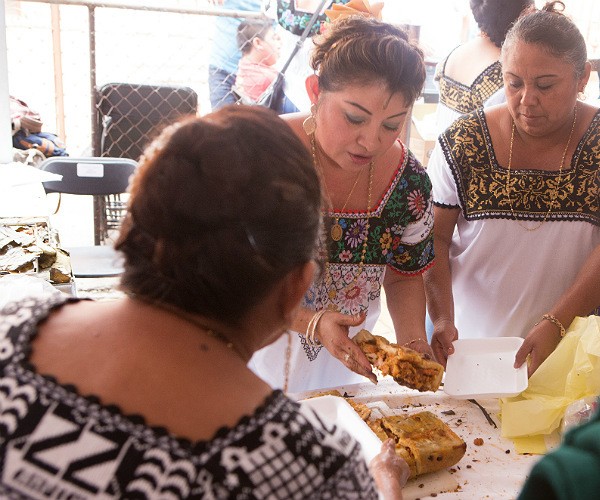 Around Mérida
As the Day of the Dead celebrations take place in the evening, daytimes are free to explore the surrounding areas, which include ancient Mayan ruins, cenotes, the National Park of Celestun and some great art galleries. One of the smallest but best galleries to visit in town is the Fundación de Artistas. On entering the tiny courtyard, we are greeted with the sounds of omming, which I instantly mistake for a Buddhist meditation class. It turns out to be part of the installation by artist Ruben Maya, which he composed especially for this show. Inside the dark gallery, his otherworldly sculptures have been painted in fluorescent sacred words from all over the world. Meanwhile, outside the sun shines on a trickling fountain, as world-class pianist, Seth Montfort, who has taken up a temporary residency here, gets ready to wow us with his classical repertoire. This is a truly wonderful place to sip a coffee and enjoy the delights of art and music!
Around Mérida
As the Day of the Dead celebrations take place in the evening, daytimes are free to explore the surrounding areas, which include ancient Mayan ruins, cenotes, the National Park of Celestun and some great art galleries. One of the smallest but best galleries to visit in town is the Fundación de Artistas. On entering the tiny courtyard, we are greeted with the sounds of omming, which I instantly mistake for a Buddhist meditation class. It turns out to be part of the installation by artist Ruben Maya, which he composed especially for this show. Inside the dark gallery, his otherworldly sculptures have been painted in fluorescent sacred words from all over the world. Meanwhile, outside the sun shines on a trickling fountain, as world-class pianist, Seth Montfort, who has taken up a temporary residency here, gets ready to wow us with his classical repertoire. This is a truly wonderful place to sip a coffee and enjoy the delights of art and music!
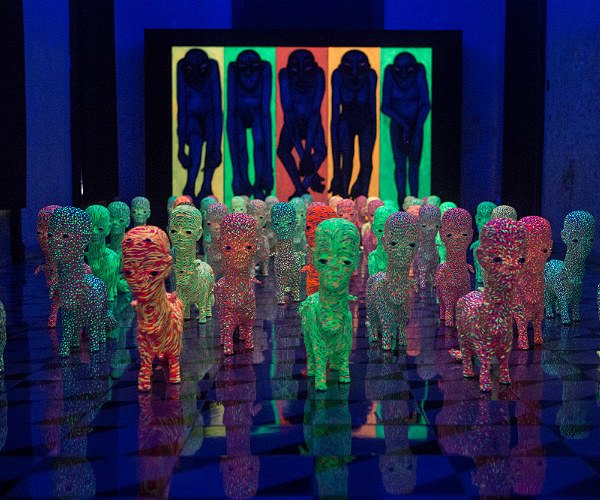
Did you enjoy this article?
Receive similar content direct to your inbox.


A really pleasant and heart-warming read! The concept of the festival is incredibly positive despite its potential to sound morbid. ‘El día de los muertos’ is becoming so popular and it is great to see. It’s such a contrast to the standard Halloween gimmicks plastered everywhere in some countries at that time of year.
Thanks Chloe! There is a very happy vibe in the town, all the warm smiles really make you feel welcome.
Thanks Chloe and Patrick! There is a very happy vibe in the town, all the warm smiles really make you feel welcome. Its also great fun to get your face painted to blend in a little.
Since seeing this in the latest James Bond film, I’ve really wanted to see it in person. Nice pics you took :)
Hi, I’m hoping to enjoy the festivities this year in Mérida. When will Hanal Pixan be celebrated? October 27th or November 3rd?
Hi Jennika,
I want to experience Day of the Death in Merida this year (2019). I’ve read your article where you’re saying “Public festivities in Mérida begin on the night of 28th October”. Will they also continue to the end (2d November)? And do you have any advise on which day (or days) a tourist can best fully experience day of the dead?
Thanks in advance! Andy